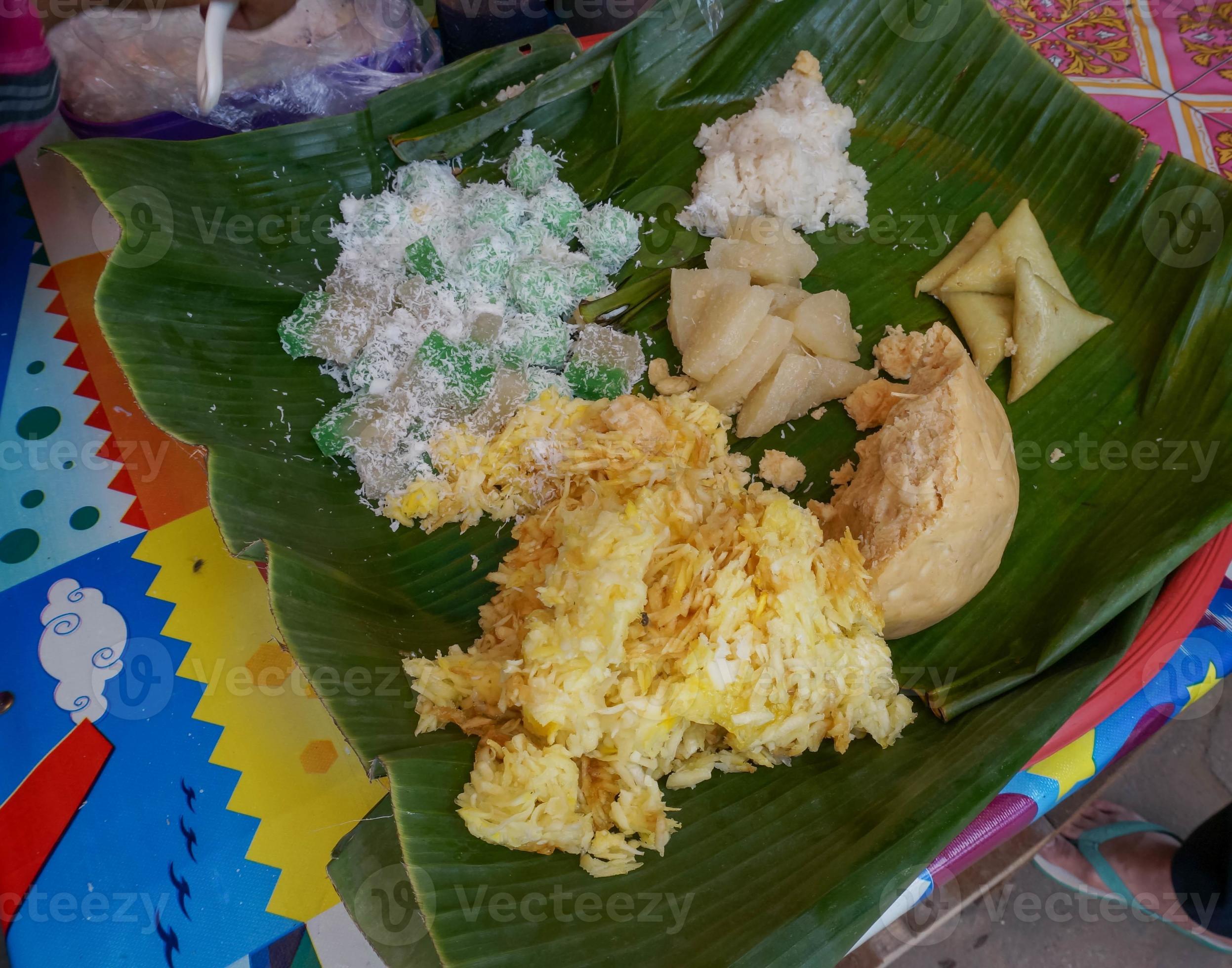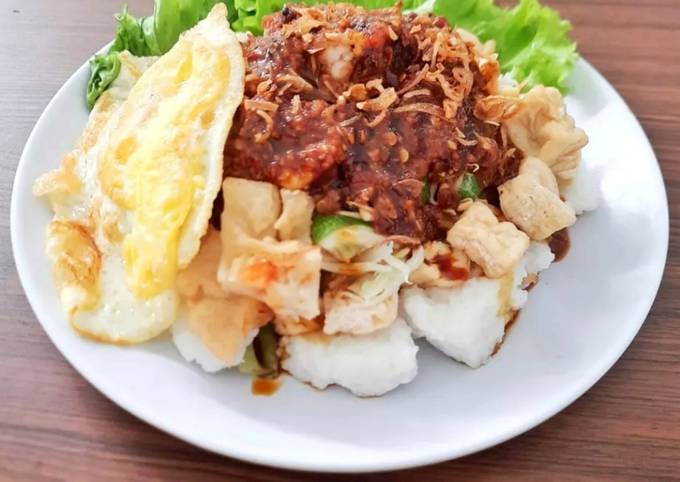![]()
Of course. Here is a 1,200-word article about the unique and iconic Indonesian dish, Rujak Cingur.
Rujak Cingur: The Bold, Unforgettable Taste of Surabaya’s Soul
In the vast and vibrant culinary landscape of Indonesia, few dishes command as much attention, curiosity, and debate as Rujak Cingur. To the uninitiated, its description can sound like a culinary dare: a motley salad of tropical fruits, blanched vegetables, rice cakes, and fried tofu, all drenched in a thick, dark, pungent sauce made from fermented shrimp paste. And then comes the star ingredient, the one that gives the dish its name and its notorious reputation: cingur, the boiled and sliced muzzle of a cow.
For many, the initial reaction is a mix of intrigue and apprehension. Cow’s snout? In a fruit salad? Yet, for the people of Surabaya, the bustling port city in East Java where the dish was born, Rujak Cingur is not a novelty; it is an institution. It is a source of fierce local pride, a comforting staple, and a flavourful testament to the city’s bold, direct, and unpretentious character. To truly understand East Java, one must understand Rujak Cingur—a dish that is far more than the sum of its seemingly disparate parts. It is a symphony of textures, a collision of flavours, and a delicious dive into the heart of Indonesian street food culture.
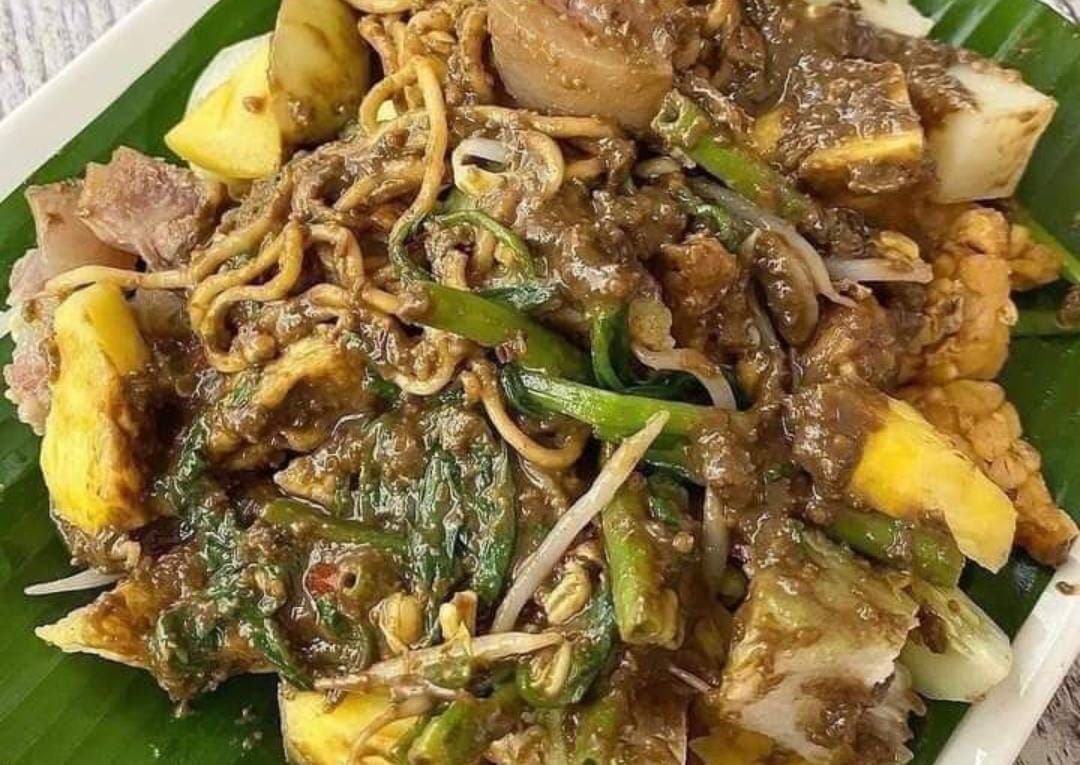
The Anatomy of a Culinary Icon
At first glance, a plate of Rujak Cingur can appear chaotic, a wild jumble of ingredients bound together by its distinctive, almost black, sauce. But within this chaos lies a carefully orchestrated balance. Each component is chosen to contribute a specific texture and taste, creating a complex and deeply satisfying whole.
The Cingur: Let’s address the elephant—or rather, the cow—in the room. The cingur is the defining element. The word itself means "muzzle" or "snout" in Javanese. The preparation is a labour of love. The snout, which consists of the lips and nose cartilage, is meticulously cleaned and then boiled for hours with herbs and spices like galangal, bay leaves, and lemongrass. This long, slow cooking process transforms what could be tough and unpalatable into something wonderfully tender and gelatinous. It has a unique, slightly springy and chewy texture that absorbs the flavour of the sauce beautifully. When prepared correctly, the cingur itself has a very mild, clean taste, serving primarily as a textural counterpoint to the other ingredients.
The Medley: The "rujak" part of the name refers to the salad mixture. Unlike Western salads, Indonesian rujak is a playground of contrasts. In a typical Rujak Cingur, you will find:
- Fruits: Unripe, crunchy fruits provide a sour and sweet tang. Common additions include young mango (mangga muda), jicama (bengkoang), ambarella (kedondong), pineapple, and cucumber.
- Vegetables: To add a fresh, green element, vendors lightly blanch vegetables like water spinach (kangkung), long beans (kacang panjang), and bean sprouts (tauge).
- Proteins and Carbs: To make the dish a substantial meal, it’s bulked up with slices of compressed rice cake (lontong), fried tofu (tahu goreng), and fermented soybean cake (tempeh goreng). These starchy and savoury elements act as sponges for the powerful sauce.
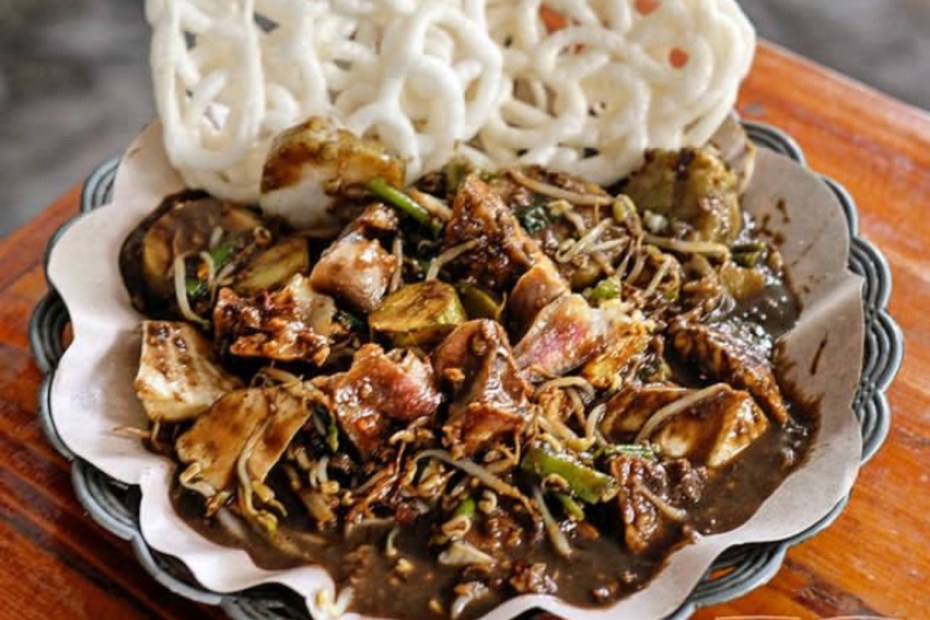
The Soul of the Dish: The Bumbu Petis

If the cingur is the dish’s signature, the sauce—or bumbu—is its soul. This is where the magic truly happens. The sauce for Rujak Cingur is not pre-made in a large batch. It is traditionally ground fresh to order by the vendor in a large stone mortar and pestle (cobek and ulekan). Watching a skilled Rujak Cingur vendor at work is a performance in itself.
The base of this formidable sauce is petis udang, a thick, black, intensely savoury paste made from fermented shrimp or prawn heads. It is the undisputed king of East Javanese condiments, delivering an umami punch that is deep, salty, and slightly sweet. To this base, the vendor adds a handful of roasted peanuts, a generous scoop of palm sugar (gula merah), a splash of tangy tamarind water, fiery bird’s eye chilies (to the customer’s desired level of spiciness), a clove of garlic, and sometimes a pinch of salt. A secret ingredient often used by traditional vendors is a slice of young, stoney banana (pisang klutuk), which adds a subtle astringency that helps to balance the richness of the petis.
The rhythmic grinding of the ulekan against the cobek blends these ingredients into a thick, velvety, and aromatic paste. A little water is added to achieve the perfect consistency—thick enough to coat every ingredient, but fluid enough to pool enticingly at the bottom of the plate. The resulting flavour profile is a mind-bending explosion: it is simultaneously sweet, spicy, savoury, sour, and deeply umami. It is this assertive, complex sauce that unifies the eclectic mix of fruit, vegetables, and cingur into a coherent and utterly addictive dish.
A Taste of Surabaya’s Character
Rujak Cingur is more than just food; it’s a reflection of its birthplace. Surabaya is Indonesia’s second-largest city, a historic port known for its industrious, straightforward, and resilient people, often referred to as Arek Suroboyo. The city’s personality is mirrored in its signature dish. Rujak Cingur is not subtle or delicate. It is bold, in-your-face, and unapologetically itself. It doesn’t try to hide its pungent, fermented flavours; it celebrates them.
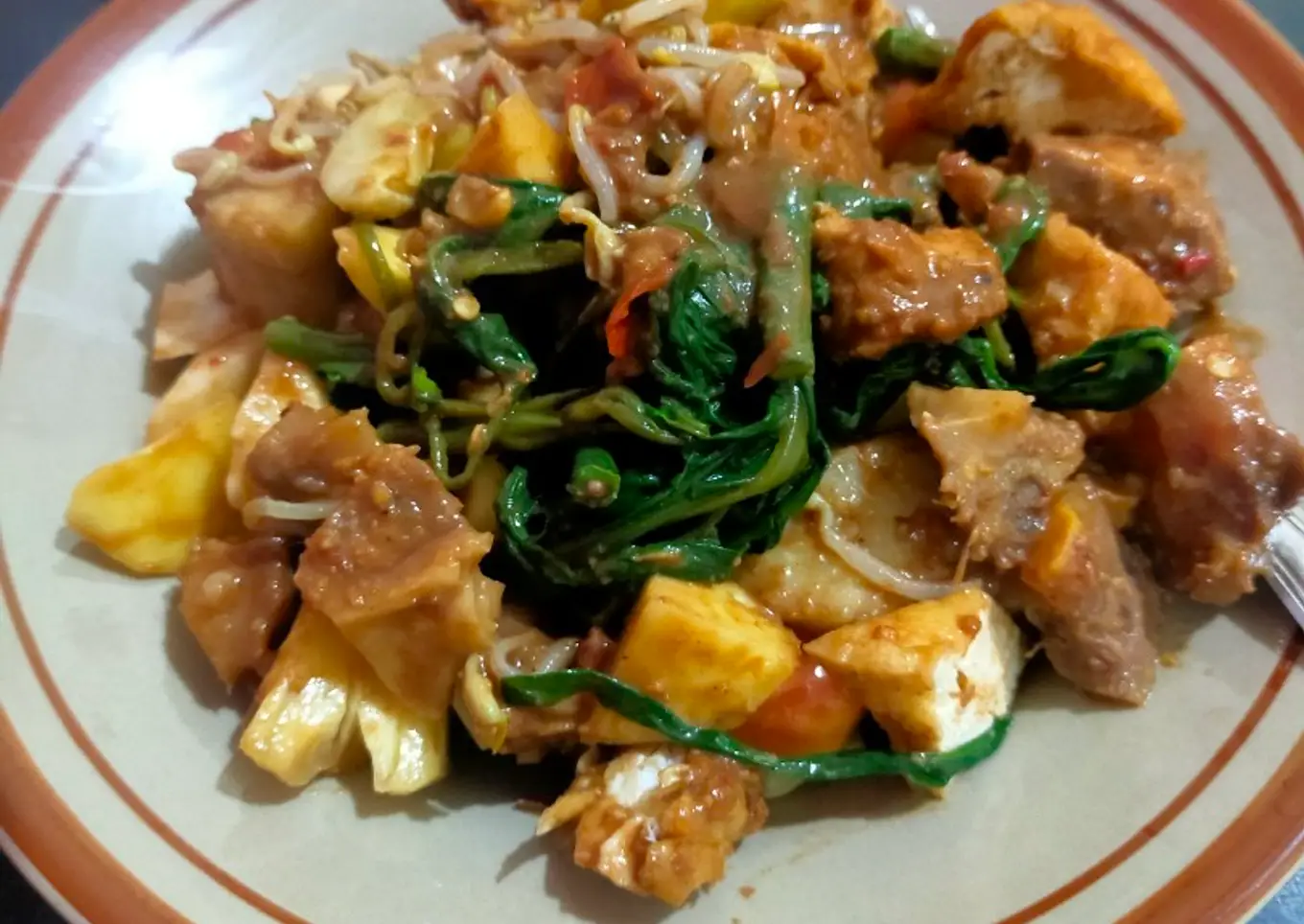
This culinary boldness is a hallmark of East Javanese cuisine, which heavily features petis in many of its famous dishes, from Tahu Tek to Lontong Balap. The use of humble, often overlooked ingredients like the cow’s muzzle also speaks to a resourceful, no-waste food culture rooted in making the most of everything available. It’s a dish born not in the kitchens of palaces, but on the streets and in the warungs (small, family-run eateries) that serve the working people of the city.
The Cingur Conundrum: A Culinary Challenge?
For outsiders, and even for some Indonesians from other regions, Rujak Cingur can present a culinary gauntlet. The idea of eating snout, combined with the intense aroma of fermented shrimp paste, can be a hurdle. It is, without a doubt, an acquired taste.
However, to dismiss it out of hand is to miss out on one of Indonesia’s most unique gastronomic experiences. The key is to approach it with an open mind. The texture of the cingur is often the biggest surprise for first-timers; it’s not slimy or tough, but pleasantly chewy and gelatinous, similar to well-prepared tendon or tripe in other Asian cuisines. The flavour of the cingur itself is neutral, allowing it to become a perfect vehicle for the sauce.
For those willing to take the plunge, the reward is immense. A spoonful of Rujak Cingur delivers a carnival of sensations. The crunch of the jicama, the soft chew of the lontong, the springiness of the cingur, the sour burst of the mango, and the slight bitterness of the water spinach, all harmonised by that rich, all-encompassing sauce. It’s a dish that engages every part of the palate and leaves a lingering, unforgettable impression.

Where to Find the Real Deal
While you might find Rujak Cingur in other parts of Indonesia, particularly in cities with large East Javanese populations, nothing compares to eating it in its native Surabaya. Here, it is everywhere—from humble street carts with a single well-worn cobek to legendary warungs that have been serving the same beloved recipe for generations. The best vendors are masters of their craft, adjusting the spice level and the balance of the sauce to each customer’s preference, their hands moving with the practiced ease of long experience.
Rujak Cingur is a dish that tells a story. It speaks of a city’s history, a people’s character, and a culture’s ingenuity. It challenges culinary preconceptions and rewards the adventurous with a flavour experience unlike any other. So, the next time you find yourself in the vibrant, energetic streets of Surabaya, listen for the rhythmic sound of grinding, follow the pungent, sweet scent of petis, and dare to be bold. Order a plate of Rujak Cingur. You won’t just be eating a meal; you’ll be tasting the very soul of East Java.

The unique and iconic Indonesian dish, Rujak Cingur. pictures collections gallery
The unique and iconic Indonesian dish, Rujak Cingur. is a nice pictures and stock photo for your computer desktop or your smartphone device (ipad, tablet, blackberry, iphone, and other device) and also for your personal use. Free available for desktop wallpaper or additional image collections for your all needs. And was uploaded by admit at date July 1, 2025. You can download it in your computer by clicking download button to save image... have nice day and have fun guys..
This 1 image in featured post from 0 Photos/images Gallery and awesome picture selections about The unique and iconic Indonesian dish, Rujak Cingur. is available to download. "Download & Save" images/pictures/wallpapers now and this Is one of the post that listed in packed to Category is Foods directory, with image dimension/resolution size is 1500 × 900 px and size image/picture file is 104 KB with original link post ID is : https://powae.pw/of-course-here-is-a-1200-word-article-about-the-unique-and-iconic-indonesian-dish-rujak-cingur/. Get download/save images in post and gallery, "download" images or "preview" it on a bigger image for spesification sample in Large size (full attachment size) here : [Download & View to Large size]. Just Simple way, in thumbnail or in Gallery. *Click images to view Large Size.We collect this wonderful image from online and choose one of the best for you. Pictures collection that posted here was carefully chosen and published by author after choosing the ones which are best among the others. So, ultimately we make it and here these list of best image for your inspiration and informational reason regarding the The unique and iconic Indonesian dish, Rujak Cingur. as part of blogsite exclusive updates collection. So, take your time and find the best informations and pictures posted here that suitable with your needs and use it for your own collection and personal use. About Image information: Image has been submitted and You are able to give your opinion as evaluations to our web site value.
Don't forget to comment if you interest with this images, you can share this post to social media like as facebook, twitter, google+, pinterest, stumbleupon, and more. just click social media buttons for share this post The unique and iconic Indonesian dish, Rujak Cingur. Now. :)
Thanks for your visit, I hope you happy come to opo wae, wis opo wae, and get what you're looking for. And hope sometimes you will come back again here. All you need to do is help us develop by discussing this The unique and iconic Indonesian dish, Rujak Cingur. if you like it "leave your comment". have fun, Thank you.



